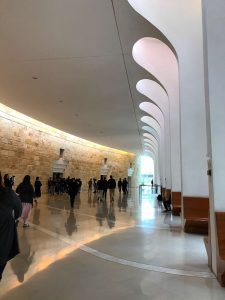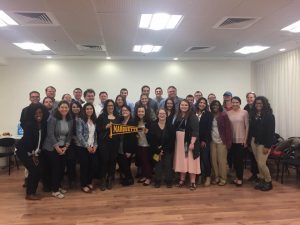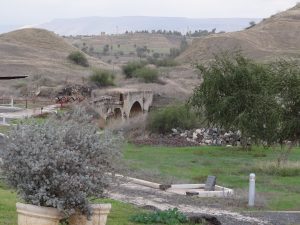Israel Reflections 2017–The Israeli Supreme Court
 This year we were able to meet with two different former Israeli Supreme Court Justices–at the beginning and at the end of the trip–which provided great bookends to our week of learning. Student Celeste Borjas reflects on the visit to the Supreme Court…
This year we were able to meet with two different former Israeli Supreme Court Justices–at the beginning and at the end of the trip–which provided great bookends to our week of learning. Student Celeste Borjas reflects on the visit to the Supreme Court…
On our last day in Jerusalem we were able to tour the Israeli Supreme Court. The Israeli Supreme Court building is conveniently situated between the Israeli Parliament building (the Knesset) and the office of the Prime Minister. Our tour guide explained that this was purposeful, and was meant to symbolize the role of the judiciary as mediator of conflict. As we entered the building, I was taken aback by the amount of natural light entering through the windows. Though it was a very rainy day, there was no need for lamps or artificial lighting in the foyer. Another physical attribute of the Court foyer that caught my eye was the aesthetic created by a wall made entirely out of Jerusalem stone (a sandy-white limestone out of which most buildings in Jerusalem are constructed) standing opposite of a clean unadorned wall of white plaster. Our tour guide explained that this juxtaposition was meant to symbolize how the laws of men on Earth should complement the ultimate pursuit of eternal justice.
One of the first things to surprise me was that the Israeli Supreme Court actually operates similarly to the United States Court of Appeals. I had originally expected the highest court in Israel to resemble the Supreme Court of the United States. Not so. Like the U.S. Court of Appeals, the Israeli Justices (13 total) typically preside over cases in panels of three. Additionally, parties to a suit are entitled to an appeal at the Israeli Supreme Court as a matter of right. Moreover, any person may directly petition the Israeli Supreme Court (and bypass the district courts) if an action by an Israeli governmental entity contradicts/contravenes the basic laws of the Knesset. This last point reminded me of the power of the D.C. Circuit to hear cases involving federal agency action.


